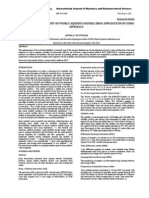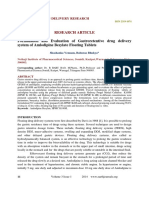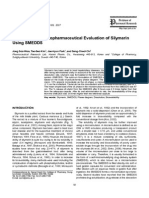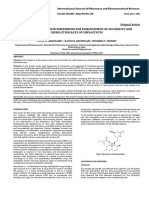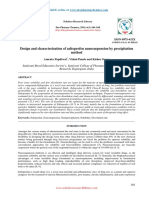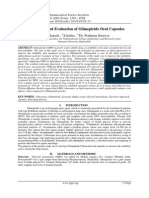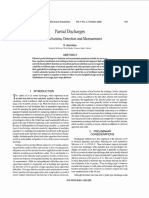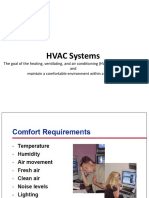Biopharmaceutical Evaluation of A Solid Dispersion System Containing Sibutramine Freebase
Biopharmaceutical Evaluation of A Solid Dispersion System Containing Sibutramine Freebase
Uploaded by
Nayara FonsecaCopyright:
Available Formats
Biopharmaceutical Evaluation of A Solid Dispersion System Containing Sibutramine Freebase
Biopharmaceutical Evaluation of A Solid Dispersion System Containing Sibutramine Freebase
Uploaded by
Nayara FonsecaOriginal Title
Copyright
Available Formats
Share this document
Did you find this document useful?
Is this content inappropriate?
Copyright:
Available Formats
Biopharmaceutical Evaluation of A Solid Dispersion System Containing Sibutramine Freebase
Biopharmaceutical Evaluation of A Solid Dispersion System Containing Sibutramine Freebase
Uploaded by
Nayara FonsecaCopyright:
Available Formats
Solid Dispersion System of Sibutramine Freebase
Bull. Korean Chem. Soc. 2008, Vol. 29, No. 4
749
Biopharmaceutical Evaluation of a Solid Dispersion System Containing Sibutramine Freebase
Minsuk Lee, Heechul Chang, Taewan Kim, Junghwa Park, Bongsang Lee, Sung Hee Kim, Do-Hwan Kim, Bo Gyun Kim, Seong Tae Oh, Myung Joo Kang, Jong Hyeok Park, Jaehwi Lee,* and Young Wook Choi* Division of Pharmaceutical Sciences, College of Pharmacy, Chung-Ang University, Seoul 156-756, Korea * E-mail: jaehwi@cau.ac.kr (JL), ywchoi@cau.ac.kr (YWC) Pharmaceutical Research Institute, Daewoong Pharmaceutical Co., Ltd., Yongin 449-814, Korea Received September 5, 2007 To increase the solubility of sibutramine freebase, the solid dispersion was prepared using a fluid-bed granulator. The solid dispersion containing sibutramine freebase was characterized by differential scanning calorimetry (DSC) and powder X-ray diffraction (XRD). After filling the sibutramine solid dispersion in the gelatin hard capsule, we performed in vitro dissolution test, the stability test under accelerated conditions and pharmacokinetic study in beagle dogs. The DSC and XRD data showed that sibutramine solid dispersion would be amorphous state. The dissolution rate of sibutramine solid dispersion was significantly increased about 70% than sibutramine freebase. The stability of sibutramine solid dispersion capsules was equivalent or above to commercial product of sibutramine. In beagle dogs, the sibutramine solid dispersion showed equivalent pharmacokinetic behavior with commercial product of sibutramine hydrochloride. In conclusion, the solid dispersion system provided a possible way to overcome the low solubility of sibutramine freebase, and the sibutramine solid dispersion can be a bioequivalent with the commercial product in humans. Key Words : Solid dispersion, Sibutramine freebase, Solubility, Pharmacokinetic behavior
Introduction Sibutramine is a serotonin and noradrenaline re-uptake inhibitor that is relatively ineffective as an antidepressant but has a pro-satiety effect.1 It has a small thermogenic effect by limiting the decline in metabolic rate that normally occurs with weight loss.2-4 Sibutramine undergoes extensive firstpass metabolism, mainly by hepatic cytochrome p450 3A4 enzymes, to active primary (M1) and secondary (M2) amine metabolites, which are more potent than the parent compound.4-6 The drug exists in an oil state at room temperature because of its low melting point, so it is difficult to handle pharmaceutically. Also, the drug has poor solubility in water. In order to increase the solubility and improve the handling of sibutramine freebase, a hydrochloride monohydrate salt form has been developed by Abbott, the original production company. It was made available commercially in a capsule dosage form under the brand name of Meridia or Redultil.7 Recently, sibutramine freebase was crystallized in a solid powder form due to the development of crystallization technology. Therefore it is not necessary to be in salt form for easy handling. However, unlike the hydrochloride salt form, sibutramine freebase itself is not soluble in water, so it did not show the same in vitro dissolution profiles as the brand drug. Generally, the change of the salts form may affect the biological properties of the drug as well as the solubility profiles and dissolution rates.8,9 Therefore, it is necessary to overcome this poor dissolution characteristic. Solid dispersions of many poorly water soluble drugs with hydrophilic carrier matrix have been formulated for improving drug
dissolution rate. Moreover, solid dispersions may improve the bioavailability of poorly water soluble drugs by increasing the drug dissolution rate and their saturation solubility in the gastrointestinal fluids.10-13 The purpose of this study was to develop the solid dispersion of sibutramine freebase having high dissolution characteristics. For the formulation study, a suitable solubilizing agent and excipients were selected and a finalized formulation containing sibutramine freebase was taken for an pharmacokinetic study with the commercial product in beagle dogs. This study was also focused on the characterization of the physico-chemical properties of sibutramine solid dispersion and the evaluation of the stability and the pharmacokinetic behaviors in beagle dogs for the prediction of bioequivalence in humans. Experimental Procedures Materials. Sibutramine freebase was purchased from Cipla (Mumbai, India), TPGS (tocopheryl polyethylene glycol 1000 succinate) was obtained from Eastman (Kingsport, USA), Cremophor RH 40 and Poloxamer 407 (Lutrol F147) were obtained from BASF (Ludwigshafen, Germany) and Gelucire 44/14 was purchased from Gattefosse (SaintPriest, France). Citric acid and other reagents were purchased from Sigma-Aldrich Company (St. Louis, USA). Animals. Healthy 6-7 months old beagle dogs (male, 6.9 0.4 kg) were purchased from Chemon Korea Inc. (Yongin, Korea). Twelve dogs were used in this study and split into two groups of six. The animals were kept in an environmentally controlled breeding room for a week before the
750
Bull. Korean Chem. Soc. 2008, Vol. 29, No. 4
Minsuk Lee et al.
start of the experiments. Each dog was fasted for 14 h prior to each study day, but water was allowed ad libitum. Formulation study. Nonionic surfactants, which were in solid or semi-solid state at room temperature, were used to make the solid dispersion for screening of solubilizing agents. TPGS, Poloxamer 407, Cremophor RH 40, Gelucire 44/14 were used in the screening test for selection of the optimal solubilizing agent. Each surfactant was mixed homogeneously with the drug at a ratio of 1:1, and the solid dispersion was prepared by addition of hydroxypropylmethylcellulose (HPMC) and mannitol to the above drug and surfactant mixture. Then the capsule filler Ludipress and a lubricant magnesium stearate were added during blending stage. Also, the effect of the acidifier (citric acid) to the formulations was evaluated because sibutramine dissolves more easily in a low pH medium. Preparation of sibutramine solid dispersion. The solid dispersion containing sibutramine freebase was made through a solvent evaporation method and co-melt method. The methods were compared with each other in terms of the dissolution behavior of sibutramine. First, the co-melt method was used to make a solid dispersion by simultaneously melting the drug and surfactant at about 50 2 oC, then HPMC was added to form the solid dispersion as the temperature was reduced. Second, the solvent evaporation method was used to make a solid dispersion by the spraying of an ethanol/water solution containing sibutramine freebase and surfactant to HPMC in a fluid-bed granulator. After the solid dispersion was prepared, other excipients, mentioned above, were added and mixed, and then each sibutramine solid dispersion formulation equivalent to 8.37 mg of sibutramine freebase was filled into gelatin hard capsules. Differential scanning calorimetry (DSC). The DSC thermograms were recorded using a DSC (Mettler-Toledo, DSC822e). Approximately 2 to 5 mg of each sample was heated in an aluminum pan with lid from 30 to 150 oC at a scanning rate of 10 oC/min under a stream of nitrogen. Powder X-ray diffraction (XRD). Powder X-ray diffraction patterns were recorded using a powder X-ray diffractometer (Mac Science, Japan, Model: M18XHF-SRA) under the following conditions: target Cu; filter Ni; voltage 40 kV; current 300 mA; receiving slit 0.15 millimeters. The data were collected in the continuous scan mode using a step size of 0.02 at 2 /s. The scanned range was 3-50. In vitro dissolution study. The dissolution test was performed in a Dissolution Apparatus II (Vankel VK7020, Varian) according to Korea Pharmacopoeia 8th edition (KP VIII) dissolution procedure. Each formulation of a commercial product as reference drug, sibutramine freebase capsule, and sibutramine freebase solid dispersion capsule (n = 6) were put into a sinker. The sinker containing formulations was placed in 900 mL of dissolution media (pH 1.2, pH 4.0, pH 6.8 and water) at 37 0.5 C with paddle speed of 50 rpm. After the dilution of dissolution sample with methanol, the concentration of sibutramine was determined by HPLC. Accelerated stability test. The sibutramine solid dispersion capsules were packed in press- through package
blisters, and stored in an incubator maintained at 40 oC and 75% RH with the commercial product for comparative stability. At appropriate time intervals, samples were withdrawn and examined. The content of sibutramine and impurities were determined by HPLC. HPLC analysis. A Gemini C18 (4.6 250 mm, 5 m, Phenomenex, Torrance, USA) column was used to analyze levels of sibutramine. The composition of mobile phase was water: acetonitrile = 64:36 (v/v). The flow rate was 1.5 mL/min, detection wavelength was 229 nm and injection volume was 10 L. In vivo absorption study in beagle dogs. Six beagle dogs were orally administered one gelatin capsule containing 10 mg of sibutramine hydrochloride, equivalent to 8.37 mg of sibutramine freebase, as reference drug or sibutramine solid dispersion with sibutramine freebase of 8.37 mg. 200 L of each blood sample was collected at designated time intervals of 0.33, 0.67, 1, 2, 3, 4, 6, 8, 10, 12, 24, 48, 72 h and it was centrifuged for 10 min at 4,000 rpm. The plasma was kept immediately at -20 C until HPLC/MS/MS analysis. Pharmacokinetic analysis. Cmax values (maximum plasma concentrations), Tmax times (times to Cmax), AUC (area under the concentration-time curve), Kel (apparent elimination rate constant) and t1/2 (half-life) of sibutramine, M1 and M2 were calculated by BA Calc 2002 program (KFDA, Korea). Results were expressed as meanS.D. Statistical comparisons between groups were conducted by paired Students ttest with the significance level of P<0.05. Blood sample analysis. Plasma concentrations of sibutramine, metabolite M1 and metabolite M2 were analyzed using a validated high-performance liquid chromatographicmass spectrometric (HPLC/MS/MS) method with a slight modification of the earlier method.14-16 Briefly, 200 L of plasma and 10 L of internal standard solution prepared with amlodipine at a concentration of 5 g/mL were added to glass tube. To this, 20 L 0.1 M NaOH and 1200 L of hexane:ethylacetate (90:10) organic solvent were added. After vigorous vortex mixing for 5 min, the mixture was centrifuged at 3000 rpm for 3 min and the organic phase was transferred to a clean glass tube and evaporated to dryness under a flow of nitrogen gas. The dry residue was reconstituted with 120 L of 50% acetonitile, and a 10 L aliquot of this reconstituted solution was injected onto the HPLC/ MS/MS system. HPLC/MS/MS analysis condition. HPLC/MS/MS system included a Shieseido Capcell Pak UG C18 column (5 m, 2.0 150 mm, Shiseido Co., Tokyo, Japan). The mobile phase consisted of 50% acetonitrile containing 0.1% formic acid. The mass spectrometer with an electrospray source was run in the positive ion mode, and m/z 280.4, 266.4, 252.3 and 409 were monitored for sibutramine, M1, M2, and internal standard, respectively. Linear calibration curves were acquired in the ranges from 0.15 to 160 ng/mL for sibutramine, M1 and M2. Results and Discussion Formulation study. The effect of various nonionic surfac-
Solid Dispersion System of Sibutramine Freebase
Bull. Korean Chem. Soc. 2008, Vol. 29, No. 4
751
Figure 1. The dissolution profiles of sibutramine from (a) reference drug, (b) sibutramine solid dispersion containing poloxamer, (c) sibutramine solid dispersion containing poloxamer and citric acid and (d) sibutramine freebase raw material at the dissolution media pH 6.8.
tants such as Poloxamer 407, Cremophor RH40, Gelucire 44/14 and TPGS on the dissolution profiles of sibutramine freebase from solid dispersions was examined. The dissolution rate of sibutramine freebase was significantly enhanced by all surfactants tested. Among the surfactants, Poloxamer 407 was most effective at increasing the dissolution rate of sibutramine in all dissolution media (buffers of pH 1.2, 4.0, 6.8 and water) and the dissolution increasing effect was more significant in the dissolution medium of pH 6.8 and water. Figure 1 shows the effect of citric acid on the dissolution profile of sibutramine. Initial sibutramine release was faster when citric acid was incorporated in the solid dispersion formulation due largely to its solubility enhancing
effect. No difference was found in the dissolution profile of sibutramine contained in the solid dispersion formuations prepared by either co-melt or solvent evaporation method. Dissolution profiles of sibutramine solid dispersion. The composition of optimized final formulation determined from the formulation study was sibutramine freebase solid dispersion that was composed of sibutramine 8.37 mg, Poloxamer 407 8.83 mg, citric acid 5.8 mg, hydroxypropylmethylcellulose 8 mg, mannitol 87 mg, silicone dioxide 13 mg, sodium carboxymethylcellulose 3 mg, Ludipress 106 mg and magnesium stearate 2 mg. Dissolution studies were performed for the commercial product, sibutramine freebase and sibutramine solid dispersion formulations. Figure 2 shows the dissolution profiles of sibutramine obtained in dissolution media having various pH values. The released sibutramine from sibutramine freebase capsule exhibited the pH-dependent and incomplete dissolution behavior. In buffers of pH 1.2 and 4.0, the released amounts of sibutramine from sibutramine freebase capsules were 101.1% and 103.4% within 60 min, whereas those were 11.7% and 17.3% in buffer of pH 6.8 and water, respectively. Solid dispersions of sibutramine freebase were prepared using surfactant and HPMC to enhance the dissolution rate. The released amounts of sibutramine from solid dispersion capsules were significantly higher than that of sibutramine from the sibutramine freebase capsules especially in buffer pH 6.8 and water media. The released sibutramine from solid dispersion capsules was also 8 to 10% higher than that from the commercial capsule. Differential scanning calorimetry (DSC). The sibutramine in solid dispersion exhibited a reduction in endothermal peak height compared to pure drug alone. As shown in Figure 3, the DSC peak of solid dispersion was smaller and broader than the sibutramine freebase peak. Moreover,
Figure 2. Comparative dissolution profiles of sibutramine from (a) sibutramine freebase drug, (b) sibutramine solid dispersion drug and (c) reference drug at various pH media.
752
Bull. Korean Chem. Soc. 2008, Vol. 29, No. 4
Minsuk Lee et al.
Figure 4. XRD graphs of (a) sibutramine freebase (crystalline raw material) and (b) sibutramine solid dispersion.
Figure 3. DSC graphs of (a) sibutramine freebase (crystalline raw material) and (b) sibutramine solid dispersion. Figure 5. Stability of sibutramine solid dispersion capsules and commercial products in an accelerated condition of 40 oC and 75% RH. Sibutramine content of commercial product ( ) and solid dispersion capsule ( ). Total impurities of commercial product ( ) and solid dispersion capsule ( ).
the peak was shifted away from the sibutramine freebase peak. From these results, it was presumed that sibutramine solid dispersion existed as non-crystalline form and there was interaction between sibutramine and carrier such as poloxamer 407 (Fig. 3). Powder X-ray diffraction (XRD). The X-ray diffraction patterns for the sibutramine freebase and the solid dispersion are depicted in Figure 4. The sibutramine freebase gave a diffraction peak corresponded to a separate crystalline drug phase. Solid dispersion prepared by co-melt method showed the absence of diffraction peak of sibutramine freebase pointing to a transition of sibutramine freebase from a crystalline to an amorphous state as a consequence of the preparation procedure. Both the DSC and X-ray results confirmed that sibutramine freebase is present as an amorphous state in solid dispersion. Accelerated stability test. At accelerated conditions under 40 oC, 75% RH, the sibutramine solid dispersion capsules exhibited slight but insignificant fall within the assay value. Total impurities were just increased up to 0.36% after storage for 6 months as shown in Figure 5. These results indicated that the sibutramine solid dispersion capsules would be very stable formulation for sibutramine freebase. In vivo evaluation in beagle dogs. HPLC/MS/MS chromatograms of sibutramine, metabolite M1, M2 and
Figure 6. HPLC/MS/MS chromatograms of (a) amlodipine as internal standard, (b) metabolite M2, (c) metabolite M1 and (d) sibutramine spiked in beagle dog plasma.
amlodipine as internal standard were shown in Figure 6. Acceptable linearity was observed over the concentration range 0.05-200 ng/mL plasma (r2 = 0.995 for sibutramine; r2 = 0.997 for M1; r2 = 0.997 for M2). Figure 7 shows the mean
Solid Dispersion System of Sibutramine Freebase
Bull. Korean Chem. Soc. 2008, Vol. 29, No. 4
753
and test drugs were 21.26 (14.95) and 27.80 (28.39) ng/mL, respectively; Tmax occurred at 0.58 (0.21) and 0.61 (0.47) h. The AUC0-72hr values were 39.80 (20.98) ngh/mL for the reference drug and 44.58 (31.72) ngh/mL for the test drug. The tl/2 were 36.99 (18.95) and 35.64 (13.53) h for the reference and test drugs. None of the differences in the pharmacokinetic properties of the 2 formulations were statistically significant. For M1 metabolite, the mean (S.D.) Cmax for the reference and test drugs were 8.70 (6.95) and 7.12 (3.66) ng/mL, respectively; Tmax occurred at 0.67 (0.14) and 0.75 (0.40) h. The AUC0-72hr values were 20.43 (13.06) ngh/mL for the reference drug and 19.29 (8.19) ngh/mL for the test drug. The tl/2 were 13.44 (4.81) and 23.58 (22.57) h for the reference and test drugs. None of the differences in the pharmacokinetic properties of the 2 formulations were statistically significant. For M2 metabolite, the mean (S.D.) Cmax for the reference and test drugs were 10.38 (6.08) and 10.28 (4.94) ng/mL, respectively; Tmax occurred at 0.73 (0.13) and 0.92 (0.67) h. The AUC0-72hr values were 35.82 (17.70) ngh/mL for the reference drug and 34.09 (13.47) ngh/mL for the test drug. The tl/2 values were 12.65 (9.65) and 9.29 (4.92) h for the reference and test drugs. None of the differences in the pharmacokinetic properties of the two formulations were statistically significant. It was found that the bioavailability of solid dispersion of sibutramine was equivalent to the reference drug. Conclusions
Figure 7. The blood concentration of sibutramine and its active metabolite M1 and M2 from (a) reference drug and (b) test drug in beagle dogs.
plasma-concentration time profiles of sibutramine, M1 and M2 metabolites of sibutramine that resulted after oral administration of either the commercial product (reference drug) and sibutramine solid dispersion formulations (test drug) to each of the six beagle dogs. The pharmacokinetic parameters of sibutramine, M1 and M2 calculated from the plasma concentration curves are summarized in Table 1. The results show that the absorption of sibutramine, M1 and M2 was fast as it appears in plasma samples withdrawn after 0.33 h in all dogs from both reference and test drugs. There were no significant differences in plasma concentrations of each observed time points between the reference and test drug. For sibutramine, the mean (S.D.) Cmax for the reference
Poloxamer 407 and citric acid were a good excipient to increase the solubility of sibutramine freebase. The preparation process of sibutramine freebase was very simple and would be applied to commercial manufacture. In vitro dissolution studies revealed that the release of sibutramine from solid dispersion formulations was higher than that of sibutramine freebase capsule and was equal to the commercial product. The sibutramine solid dispersion capsule was stable at accelerated conditions for 6 months. The pharmacokinetic parameters of sibutramine, M1 and M2 between sibutramine freebase solid dispersion and commercial product, were statistically equal in beagle dogs. With these results, the solid dispersion system provided a possible way to overcome the low solubility of sibutramine freebase, and the sibutramine solid dispersion can be a bioequivalent to the commercial product in humans.
Table 1. Pharmacokinetic parameters after administration of reference and test (sibutramine solid dispersion) drugs. Values are average S.D.
AUC0-72hr (ngh/mL) Reference Sibutramine M1 M2 Sibutramine M1 M2 39.80 20.98 20.43 13.06 35.82 17.70 44.58 31.72 19.29 8.190 34.09 13.47 Cmax (ng/mL) 21.26 14.95 8.70 6.95 10.38 6.080 27.80 28.39 7.12 3.66 10.28 4.940 Tmax (h) 0.58 0.21 0.67 0.14 0.73 0.13 0.61 0.47 0.75 0.40 0.92 0.67 t1/2 (h) 36.99 18.95 13.44 4.810 12.65 9.650 35.64 13.53 23.58 22.57 9.29 4.92 Ke (h1) 0.03 0.05 0.06 0.02 0.08 0.05 0.02 0.01 0.06 0.05 0.09 0.04
Test
754
Bull. Korean Chem. Soc. 2008, Vol. 29, No. 4
Minsuk Lee et al.
8. Davies, G. Pharm. J. 2001, 266, 322. 9. Verbeeck, R. K.; Kanfer, I.; Walker, R. B. Eur. J. Pharm. Sci. 2006, 28, 1. 10. Yamashita, K.; Nakate, T.; Okimoto, K.; Ohike, A.; Tokunaga, Y.; Ibuki, R.; Higaki, K.; Kimura, T. Int. J. Pharm. 2003, 267, 79. 11. Chen, Y.; Zhang, G. G. Z.; Neilly, J.; Marsh, K.; Mawhinney, D.; Sanzgiri, Y. D. Int. J. Pharm. 2004, 286, 69. 12. Six, K.; Daems, T.; Hoon, J.; Hecken, A. V.; Depre, M.; Bouche, M. P.; Prinsen, P.; Verreck, G.; Peeters, J.; Brewster, M. E.; Mooter, G. V. Eur. J. Pharm. Sci. 2005, 24, 179. 13. Newa, M.; Bhandari, K. H.; Li, D. X.; Kwon, T. H.; Kim, J. A.; Yoo, B. K.; Woo, J. S.; Lyoo, W. S.; Young, C. S.; Choi, H. G. Int. J. Pharm. 2007, 343, 228. 14. Li, D.; Hao, X.; Huang, X.; Zhang, S. Anal. Chim. Acta 2003, 492, 241. 15. Chen, J.; Lu, W.; Zhang, Q.; Jiang, X. J. Chromatogr. B 2003, 785, 197. 16. Park, J. Y.; Kim, K. A.; Park, P. W.; Suh, K. H.; Lee, G. S. Clin. Ther. 2004, 26, 2092.
Acknowledgements. This research was supported by the Chung-Ang University Research Grants in 2006. References
1. Heal, D. J.; Aspley, S.; Prow, M. R.; Jackson, H. C.; Martin, K. F.; Cheetham, S. C. Int. J. Obes. Relat. Metab. Disord. 1998, 22, S18. 2. James, W. P.; Astrup, A.; Finer, N.; Hilsted, J.; Kopelman, P.; Rssner, S.; Saris, W. H.; Van Gaal, L. F. Lancet 2000, 356, 2119. 3. Lean, M. E. Int. J. Obes. Relat. Metab. Disord. 2001, 25, S8. 4. McNeely, W.; Goa, K. L. Drugs 1998, 56, 1093. 5. Luscombe, G. P.; Hopcroft, R. H.; Thomas, P. C.; Buckett, W. R. Neuropharmacology 1989, 28, 129. 6. Glick, S. D.; Haskew, R. E.; Maisonneuve, I. M.; Carlson, J. N.; Jerussi, T. P. Eur. J. Pharmacol. 2000, 397, 93. 7. Wickersham, R. M. Drug Facts and Comparisons; Novak, K. K., Ed.; Wolters Kluwer Health: St. Louis, USA, 2003; p 856.
You might also like
- Hydraulic Instrutions (2) 液压焊机操作说明Document14 pagesHydraulic Instrutions (2) 液压焊机操作说明maja labo dahuNo ratings yet
- Matlab Process ControlDocument330 pagesMatlab Process ControlSunil MotepalliNo ratings yet
- 4.kalpana ArticleDocument5 pages4.kalpana ArticleBaru Chandrasekhar RaoNo ratings yet
- Solubility Improvement of Curcumin Through PVP K-30 Solid DispersionsDocument6 pagesSolubility Improvement of Curcumin Through PVP K-30 Solid Dispersionsuday_khandavilliNo ratings yet
- My Research PaperDocument10 pagesMy Research PaperMamta AroraNo ratings yet
- A A A A C CC C A A A A D D D D Eeee M M M M IIII C CC C S S S S C CC C IIII Eeee N N N N C CC C Eeee S S S SDocument5 pagesA A A A C CC C A A A A D D D D Eeee M M M M IIII C CC C S S S S C CC C IIII Eeee N N N N C CC C Eeee S S S SvouudaosuNo ratings yet
- Formulation and Evaluation of Thermosensitive Intranasal in Situ Gel of Sumatriptan Succinate by Using A Blend of PolymersDocument9 pagesFormulation and Evaluation of Thermosensitive Intranasal in Situ Gel of Sumatriptan Succinate by Using A Blend of PolymersabikeshNo ratings yet
- 2 51 1584357062 5ijmpsapr20205Document12 pages2 51 1584357062 5ijmpsapr20205TJPRC PublicationsNo ratings yet
- Design, Development of Formulation of Eperisone Hydrochrodide Floating Sustain Realease Tablet and Its EvaluationDocument22 pagesDesign, Development of Formulation of Eperisone Hydrochrodide Floating Sustain Realease Tablet and Its EvaluationabhitavNo ratings yet
- JDDR 139Document11 pagesJDDR 139Earthjournal PublisherNo ratings yet
- Formulasi Sediaan FarmasiDocument11 pagesFormulasi Sediaan FarmasiKukuh PermadiNo ratings yet
- Journal of Drug Delivery and TherapeuticsDocument7 pagesJournal of Drug Delivery and TherapeuticsKunal BhambarNo ratings yet
- Sily MarinDocument8 pagesSily MarinphamuyenthuNo ratings yet
- Agnihotri 2004Document15 pagesAgnihotri 2004Abdul QadirNo ratings yet
- Fix 1Document7 pagesFix 1ジェラールフェルナンデスNo ratings yet
- Jurnal Transdermal IbuprofenDocument12 pagesJurnal Transdermal IbuprofenRatissa Eka NingtiyasNo ratings yet
- Formulation of Solid Dispersions For EnhDocument7 pagesFormulation of Solid Dispersions For Enhpratikdhotre211No ratings yet
- 논문 - A stability-indicating HPLC method for the determination of glucosamine in pharmaceutical formulationsDocument7 pages논문 - A stability-indicating HPLC method for the determination of glucosamine in pharmaceutical formulationsjs_kim5781No ratings yet
- Felodipin TabletDocument6 pagesFelodipin TabletMelisa AprilianiNo ratings yet
- DEVELOPMENT AND FACTORIAL DESIGN OF GLYCERYL TRISTEARATE BASED SOLID LIPID NANOPARTICLES (SLNS) CONTAINING BERBERINEDocument12 pagesDEVELOPMENT AND FACTORIAL DESIGN OF GLYCERYL TRISTEARATE BASED SOLID LIPID NANOPARTICLES (SLNS) CONTAINING BERBERINERAPPORTS DE PHARMACIENo ratings yet
- LoperAmid 1Document5 pagesLoperAmid 1Hemma KusumaningrumNo ratings yet
- Preparation and Evaluation of Solid Dispersion of Terbinafine HydrochlorideDocument7 pagesPreparation and Evaluation of Solid Dispersion of Terbinafine HydrochloridelovehopeNo ratings yet
- 11 ArticleDocument10 pages11 ArticleBaru Chandrasekhar RaoNo ratings yet
- MucoadhesifDocument26 pagesMucoadhesifFeny RafnasariNo ratings yet
- AJPS - Author TemplateDocument16 pagesAJPS - Author TemplateAdityaNo ratings yet
- AJPS - Author TemplateDocument15 pagesAJPS - Author TemplatePatmasariNo ratings yet
- JURNAL PEDIATRI 19-Vol.-3-Issue-1-Jan.-2012-RA-963-Paper-19Document3 pagesJURNAL PEDIATRI 19-Vol.-3-Issue-1-Jan.-2012-RA-963-Paper-19AnditapitalokaNo ratings yet
- Ampicilina Capsula HPLCDocument10 pagesAmpicilina Capsula HPLCcarbouNo ratings yet
- Formulation and Characterization of Floating Sodium Alginate Beads of Amoxicillin For Prolonged Gastric RetentionDocument8 pagesFormulation and Characterization of Floating Sodium Alginate Beads of Amoxicillin For Prolonged Gastric Retentionk.smilyopenventioNo ratings yet
- Research Article Fast Disintegrating Combination Tablets of Omeprazole and DomperidoneDocument9 pagesResearch Article Fast Disintegrating Combination Tablets of Omeprazole and DomperidoneMuhamad Nur ArifinNo ratings yet
- Enhancement of Solubility and Bioavailability of Candesartan Cilexetil Using Natural P-Glycoprotein Inhibitors206Document6 pagesEnhancement of Solubility and Bioavailability of Candesartan Cilexetil Using Natural P-Glycoprotein Inhibitors206Noor ZulalNo ratings yet
- Pratik - Dhotre - Project GMC111Document18 pagesPratik - Dhotre - Project GMC111pratikdhotre211No ratings yet
- Formulation and Evaluation of Sustained Release Sodium Alginate Microbeads of CarvedilolDocument8 pagesFormulation and Evaluation of Sustained Release Sodium Alginate Microbeads of CarvedilolDelfina HuangNo ratings yet
- Formulation and In-Vitro Evaluation of Glibenclamide Dry Emulsion in Vegetarian CapsulesDocument5 pagesFormulation and In-Vitro Evaluation of Glibenclamide Dry Emulsion in Vegetarian CapsulesBaru Chandrasekhar RaoNo ratings yet
- 223 PDFDocument9 pages223 PDF26nazilarenoatNo ratings yet
- Formulation and Evaluation of Prednisolone Sodium Phosphate InjectionDocument8 pagesFormulation and Evaluation of Prednisolone Sodium Phosphate InjectionMiranda MileNo ratings yet
- AJPS - Author TemplateDocument15 pagesAJPS - Author TemplateAndres Riffo VillagranNo ratings yet
- SNI - 06 2385 2006 Minyak - NilamDocument8 pagesSNI - 06 2385 2006 Minyak - NilamEuis Wulan AnggraeniNo ratings yet
- 463 PDFDocument4 pages463 PDFandypedeNo ratings yet
- Formulation and Evaluation of Montelukast Sodium and Levocetirizine Dihydrochloride Sublingual TabletsDocument5 pagesFormulation and Evaluation of Montelukast Sodium and Levocetirizine Dihydrochloride Sublingual TabletsNeerajNo ratings yet
- Related LiteratureDocument6 pagesRelated LiteratureJean FlorencondiaNo ratings yet
- 1214 Full PDFDocument6 pages1214 Full PDFFeslyAnugerahAriestaPayungNo ratings yet
- 1384055589Document13 pages1384055589richardparkergreat1No ratings yet
- Design and Characterization of Zaltoprofen Nanosuspension by Precipitation MethodDocument8 pagesDesign and Characterization of Zaltoprofen Nanosuspension by Precipitation Methodsunaina agarwalNo ratings yet
- Formulation and Evaluation of Glimepiride Oral CapsulesDocument13 pagesFormulation and Evaluation of Glimepiride Oral CapsulesinventionjournalsNo ratings yet
- DT200905 A05Document6 pagesDT200905 A05Tarek ShadyNo ratings yet
- Role of Functionalized Guar Gum in Solid Dispersion of Non-Steoidal Anti-Inflammatory DrugDocument11 pagesRole of Functionalized Guar Gum in Solid Dispersion of Non-Steoidal Anti-Inflammatory DrugIJAR JOURNALNo ratings yet
- 10 1 1 509 9662 PDFDocument5 pages10 1 1 509 9662 PDFRizky AdyaNo ratings yet
- Pharmaceutical Development and Compatibility Studies On Cytarabine InjectionDocument4 pagesPharmaceutical Development and Compatibility Studies On Cytarabine InjectionAmit KhuntNo ratings yet
- Enhancement of Dissolution and Bioavailability of Fenofibrate by Solid Dispersion With Sodium Citrate HPMC and Sugar DerDocument12 pagesEnhancement of Dissolution and Bioavailability of Fenofibrate by Solid Dispersion With Sodium Citrate HPMC and Sugar DerMaryamNo ratings yet
- Shiv IJCRRDocument10 pagesShiv IJCRRnavodaya9No ratings yet
- 20DE1ROO58@PJWDocument24 pages20DE1ROO58@PJWmirahsanali69No ratings yet
- 26537-Article Text-147230-1-10-20190103 PDFDocument4 pages26537-Article Text-147230-1-10-20190103 PDFSoheil JafariNo ratings yet
- 26537-Article Text-147230-1-10-20190103 PDFDocument4 pages26537-Article Text-147230-1-10-20190103 PDFSoheil JafariNo ratings yet
- Amytriptilin FormulationDocument7 pagesAmytriptilin FormulationWahyu RedfieldNo ratings yet
- Formulation Optimization and Evaluation of Orodispersible Tablets of An Antipsychotic Drug Using Solubility Enhancement TechniqueDocument25 pagesFormulation Optimization and Evaluation of Orodispersible Tablets of An Antipsychotic Drug Using Solubility Enhancement TechniqueJOURNAL CLUB FOR PHARMACEUTICAL SCIENCES (JCPS)No ratings yet
- 17 (1311 1313) JS11Document3 pages17 (1311 1313) JS11Anonymous Czy6tEiNo ratings yet
- FlubiprofenDocument5 pagesFlubiprofenPradeep BhimaneniNo ratings yet
- Prolonged Gastric Delivery of Vitamin B2 From A Floating Drug Delivery System: An in Vitro StudyDocument7 pagesProlonged Gastric Delivery of Vitamin B2 From A Floating Drug Delivery System: An in Vitro Studyzend_timoNo ratings yet
- Solid Dispersion ........Document31 pagesSolid Dispersion ........Rishikesh ChakorNo ratings yet
- Practical Handbook of Pharmaceutical Chemistry for M.PharmFrom EverandPractical Handbook of Pharmaceutical Chemistry for M.PharmNo ratings yet
- A Comprehensive Book on Experimental PharmaceuticsFrom EverandA Comprehensive Book on Experimental PharmaceuticsRating: 5 out of 5 stars5/5 (1)
- Bazi Ar 2007Document17 pagesBazi Ar 2007Arda YıldırımNo ratings yet
- Partial Discharges: Their Mechanism, Detection and MeasurementDocument46 pagesPartial Discharges: Their Mechanism, Detection and MeasurementthetrasancosNo ratings yet
- Technical Specification of Hot Coiled Helical Springs Used in LocomotivesDocument23 pagesTechnical Specification of Hot Coiled Helical Springs Used in LocomotivesBittu BossNo ratings yet
- SAIC-J - 6501 - Rev 0Document7 pagesSAIC-J - 6501 - Rev 0Adel KlkNo ratings yet
- Agilent 7697A Headspace Sampler: Installation and First StartupDocument74 pagesAgilent 7697A Headspace Sampler: Installation and First StartupRodrigo ChirinoNo ratings yet
- Modeling of Power System in PSCAD/EMTDC ProgramDocument22 pagesModeling of Power System in PSCAD/EMTDC ProgramboopelectraNo ratings yet
- Ballistic Pendulum: EquipmentDocument6 pagesBallistic Pendulum: EquipmentIsraelNo ratings yet
- Design and Development of Screw-Type Pellet Machine For Aquatic Feeds With Dual Operations (#1253664) - 2962967Document10 pagesDesign and Development of Screw-Type Pellet Machine For Aquatic Feeds With Dual Operations (#1253664) - 2962967Arsene Junior Fotso WaboNo ratings yet
- A Beryllium Detector For Field ExplorationDocument12 pagesA Beryllium Detector For Field Exploration51hundredNo ratings yet
- QRMlibDocument142 pagesQRMlibmthschmittNo ratings yet
- VX Spectra - JoshuaDocument1 pageVX Spectra - JoshuaJoshua SitorusNo ratings yet
- Atmospheric Attenuation in Microwave 47 GHZ EME and VK3UM PDFDocument7 pagesAtmospheric Attenuation in Microwave 47 GHZ EME and VK3UM PDFmiguel.pelicano@gmail.comNo ratings yet
- HVAC SystemDocument66 pagesHVAC Systemmrccahmed100% (1)
- 02 Rao Elements 2004 ch2Document52 pages02 Rao Elements 2004 ch2Raybel ArgosinoNo ratings yet
- Lecture Notes MRI (Part2)Document51 pagesLecture Notes MRI (Part2)cavron100% (1)
- BS Iso 02219-2010Document34 pagesBS Iso 02219-2010Ahmed SalehNo ratings yet
- CHAPTER 08 (Practice Questions Q.P)Document14 pagesCHAPTER 08 (Practice Questions Q.P)maria zaheerNo ratings yet
- Light - 19 - Numericals On Lenses - Umang 3Document47 pagesLight - 19 - Numericals On Lenses - Umang 3Abdul KarimNo ratings yet
- Kapsel A - Temperature, Heat and ConductorsDocument71 pagesKapsel A - Temperature, Heat and ConductorsNabilla NasrilNo ratings yet
- Lecture 3: Design II: Ch. 4: Deflection and StiffnessDocument11 pagesLecture 3: Design II: Ch. 4: Deflection and StiffnessmariaNo ratings yet
- Depth of Investigation of Collinear Symmetrical Four Electrode Arrays-1Document7 pagesDepth of Investigation of Collinear Symmetrical Four Electrode Arrays-1Rigoberto Jimenez GonzalezNo ratings yet
- 38CrSi DatasheetDocument3 pages38CrSi DatasheetKashif MohiuddinNo ratings yet
- T 144Document4 pagesT 144rowatersNo ratings yet
- Guide To Ledit For VLSIDocument11 pagesGuide To Ledit For VLSIprof_x_2010No ratings yet
- Toefl 2Document17 pagesToefl 2Tonggo Margaretha ButarbbutarNo ratings yet
- Dampers & De-Tuners: Reducing Vibration of Marine Engines: Facebook Twitter Google+ Linkedin PinterestDocument5 pagesDampers & De-Tuners: Reducing Vibration of Marine Engines: Facebook Twitter Google+ Linkedin PinterestrajishrrrNo ratings yet
- Matrices and Calculus - 1Document7 pagesMatrices and Calculus - 1Murali KrishnanNo ratings yet





